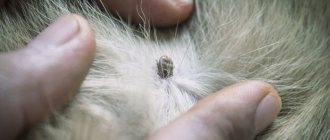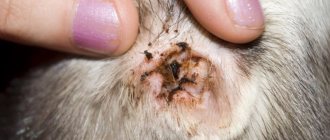Urine tests in veterinary medicine are a test that is necessary for many diseases of pets, but owners often neglect this purpose for one reason only: it is difficult to collect a sample.
But what should you do if your vet suspects your cat or dog has kidney disease or urolithiasis? Or have these diagnoses been established and constant monitoring of the condition is necessary? Experienced owners and veterinarians have come up with many ways to collect a quality specimen.
Reasons for taking a urine test
A urine test is necessary if the cat has symptoms indicating the presence of pathologies in the bladder or urinary tract. These include:
- frequent but fruitless trips to the litter box;
- changes in the color of urine, the appearance of blood and pus in it;
- painful emptying of the bladder, accompanied by loud meowing;
- the appearance of a strong odor in urine;
- ignoring the tray.
If your cat often goes to the litter box, but there are no results, it may be developing kidney failure or a blocked urinary tract. In this case, urgent assistance from a veterinarian is required. The normal color of cat urine is light yellow, but if it darkens, there is a disorder in the urinary system. The appearance of bloody spots may be a consequence of damage to the canal by an emerging stone. Pus in the urine appears during infectious processes.
When the urethra or kidneys become inflamed, pain appears during emptying of the bladder, causing the cat to meow loudly. In healthy animals, urine does not have a strong odor. Its appearance indicates the proliferation of bacteria in the genitourinary organs. Ignoring the tray is not always the cat’s revenge, his desire to mark his territory. This may be incontinence caused by a disease.
In what cases does it become necessary to collect cat urine for analysis?
Cats, like people, are susceptible to diseases such as cystitis , urolithiasis or inflammation of the genital organs . Animals may also have kidney or liver problems.
If the owner notices that the pet has begun to visit the litter box more often, meows pitifully when urinating , or vice versa, cannot go to the toilet, this is a serious reason to contact a veterinary clinic.
If the cat begins to visit the litter box more often, this is a reason to contact the veterinarian.
What you should pay attention to
Kidney disease may be accompanied by high fever.
- If you have urolithiasis, cystitis or inflammation of the reproductive organs, the cat goes to the toilet more often than usual . But it also increases the amount of urine.
- Kidney problems can cause the animal to stop urinating altogether. Kidney disease may be accompanied by high fever and lack of appetite.
- Another sign that a cat has problems with urination can be the fact that a pet trained to use a litter tray suddenly begins to pee on a rug, sofa or bed.
An important nuance: the cat urine collected for analysis must be at least twenty milligrams and it must be delivered to the veterinary clinic within two hours, otherwise its chemical composition may change and it will become unusable.
This is interesting: Causes of tartar in cats
Analysis methods
There are several ways to collect urine from cats. Not all of them can be used at home. You can collect analysis:
- cystocentesis;
- catheterization;
- urine collector;
- from the tray, toilet.
Cystocentesis for urine collection is used by specialists in veterinary hospitals. During the procedure, the abdominal wall and bladder are pierced with a needle. Catheterization is also performed by a veterinarian. This technique is used when independent urination is impossible. A catheter is inserted into the pet's bladder, and urine comes out through a tube.
At home, you can use a urine bag designed for babies. You can collect urine from the tray if it has been well cleaned and disinfected before. Some owners train cats to relieve themselves in the toilet. To collect the analysis, you should block the drain and put a polyethylene film. After urination, pour the urine into a container.
How to properly collect urine
If urine collection is done at home, then for analysis it is better to use a portion of urine that accumulates in the bladder over a long period. Therefore, the best time to collect urine is in the morning. This eliminates daily fluctuations in indicators and more objectively characterizes the parameters under study.
Urine should be collected in a plastic, disposable urine container with a tight-fitting lid. It is best that the container is sterile. Urine samples in randomly adjusted and poorly closed containers may become contaminated during storage, which leads to changes in the physicochemical properties of urine. Using disposable plastic containers with screw caps avoids most negative changes in sample storage. You can always get such a container for free from your doctor and laboratory, or you can buy it at a regular medical pharmacy.
If you have a male , then you need to take a container for urine and a second person - an assistant - with you outside. One person holds the dog on a leash, and the second, at the time of urination, places an open container under the stream of urine and takes a medium portion of urine. After this, the container must be immediately tightly closed with a lid and delivered to the laboratory for research within 1 hour.
If you have a bitch , then you first need to prepare a flat tray at home for collecting urine. It should be washed thoroughly without detergents, rinsed well, and doused with boiling water. When going outside, you need to take with you a prepared tray, a container for urine and a second person – an assistant. One person holds the dog on a leash, and the second, at the moment of urination, places a tray under the stream of urine and takes away the average portion of urine. After this, the urine should be poured into a container, the lid should be tightly closed and delivered to the laboratory for testing within 1 hour.
If your cat uses a litter box : empty the litter tray, wash it thoroughly without detergents, rinse well, pour boiling water over it and place it in its usual place. You can put a clean, thick plastic bag on top of the filler, previously washed and scalded with boiling water, and make several depressions in the filler into which the urine will drain. Observe the cat and immediately drain the urine into a prepared container, close the lid tightly, and transport it to the laboratory for testing within 1 hour.
If your cat has used a sink or bathtub as a toilet : clean the sink/tub without using household chemicals, rinse it thoroughly with running water and cover the drain with clean food packaging film so that a depression is formed at the drainage site. You can take a disposable clean bag and cut off a corner of it so that you get a cone, the base of which is slightly larger than the diameter of the drain. Monitor the cat and immediately drain the urine into a container, close the lid tightly, and take it to the laboratory for testing within 2 hours.
Remember that traces of detergents and other household chemicals change important characteristics of urine.
For analysis, at least 5-10 ml of urine is needed , but 20-100 ml is better, since diagnostically important cellular elements may not be included in a small amount of urine. Urine must be delivered to the laboratory immediately after collection. The study must be carried out no later than 2 hours after receiving the material. When urine is stored for a long time in light and heat, the destruction of cellular elements occurs, which leads to false negative results.
Urine can also be obtained directly in the clinic through bladder puncture or catheterization.
Features of cystocentesis
The main advantage of cystocentesis is the guarantee of sterility and accuracy of the analytical results obtained. It is highly undesirable to carry out such a procedure without medical skills. If you have such experience, you can collect urine from your cat at home. During the procedure, the pet can:
- stand;
- lie on your back;
- lie on your side.
Every effort should be made to calm the cat and she should remain motionless until the needle is removed. If you choose the right position and injection site, the animal will not feel pain.
Calming your pet is important not only to prevent sudden movements. In a relaxed body, the bladder is easier to palpate. Further actions are as follows:
- feel the bubble, fix it;
- gently move the organ towards you;
- smoothly and slowly insert the needle into the skin;
- continue insertion until the cannula comes into contact with the body;
- carry out the sampling, relax the bubble, carefully remove the needle.
Usually there are no negative consequences after this procedure. A hematoma may form at the site where the needle was inserted; it will gradually resolve on its own. If the vagus nerve is irritated during sampling, shortness of breath, gagging, and hiccups may occur. There is a risk of bladder rupture if there is urethral obstruction. Veterinarians, when detecting this pathology, choose a different method of collecting urine.
Collecting urine if the cat goes to the bath
Sometimes a cat is trained to go to the toilet not in the litter box, but in the bathroom or sink. In such a situation, collecting urine is quite simple, despite the fact that at first glance it may seem like a very difficult task. First, the sink or bathtub is thoroughly cleaned. Detergents cannot be used. Then cover the inside with several layers of cling film so that there is a depression at the drainage site.
© shutterstock
After the cat has urinated, the urine is collected in a syringe without a needle. It is then poured into a container for transportation. The dirty film is removed. We can say that when urine is collected in this way, the animal feels most comfortable, but only if the cat is accustomed to going to the toilet in this way.
Specifics of catheterization
Catheterization is performed only in extreme cases. This method has a high risk of infection in the urinary system. But such a procedure is necessary for urolithiasis, the presence of malignant tumors, and urethral obstruction. Before installing the catheter, a massage is performed to reduce and move sand plugs. In some cases, after this procedure, the ability to urinate is restored.
Anesthesia is not always used during catheterization; the animal has the opportunity to survive the procedure without pain relief. It additionally uses drugs that dissolve stones and sand plugs. The catheter is installed by a veterinarian, after which the medications necessary to eliminate the risk of infections and eliminate painful symptoms are prescribed. Usually prescribed:
- antispasmodics;
- anti-inflammatory drugs;
- antibacterial drugs.
The doctor may also prescribe anesthetics.
Sediment in urine and its interpretation
After the test results arrive, the cat owner runs the risk of getting confused in complex terminology that only a veterinarian can explain. However, if you want to take matters into your own hands and independently understand the criteria for assessing urine, you can read the article on our portal, which describes all the intricacies of urine analysis in cats.
Understanding test results is not easy at all.
We will briefly highlight the options for sediment in the urine and its possible causes in the table.
Table 1. Sediment in cat urine and its significance
| Type of sediment | Description |
| Slime | The presence of mucus may be normal if the indicators are appropriate. Exceeding these indicators most often indicates cystitis and other inflammatory processes in the kidneys or bladder |
Fat | Contained in different quantities in animals depending on their diet. Excess fat indicates pathologies associated with the kidneys, which are clarified with the help of further tests. |
Leukocytes | Single inclusions of leukocytes are acceptable in healthy cats. Their increase indicates infection of the urinary tract, or non-compliance with the rules for collecting urine |
| Red blood cells | The presence of red blood cells in any quantity indicates the occurrence of bleeding, which can be localized in any part of the urinary system. Often red blood cells indicate the appearance of a wound as a result of injury to the walls of the bladder with a stone |
Crystals | Insoluble salts that form crystals are present in the bodies of all cats. You need to pay attention to them if there is an overabundance of crystals, which is considered a sure harbinger of urolithiasis |
| Cylinders | In healthy cats, casts are not detected in the urine, which means they are a sign of a developing pathology. Casts are often found in animals with urethral obstruction because they contribute to the formation of plugs that block the urethra |
Using a urine bag
You can take an analysis using a urine collection bag. If there is no special device for animals, you can purchase a device intended for infants at the pharmacy. The edges of the container into which urine will be collected are treated with an adhesive compound. It needs to be fixed in the genital area. Most likely, the pet will be dissatisfied with the presence of a foreign object on the body and will make every effort to remove it. You need to wear a diaper that will block access to the urine collection bag.
This urine collection device should be used as follows:
- wash and disinfect hands;
- remove the container from the packaging;
- remove the protective tape;
- secure the container in the genital area;
- put on a diaper.
When the container is full, the urine collector is carefully removed, and the urine is poured into a container that must be prepared in advance.
How to make a cat pee?
Since cats are quite sensitive animals, they are often exposed to various diseases. Cat diseases can be different, but most of them are infectious in nature. Accordingly, most animal diseases appear in case of contact with sick individuals.
Most often, unvaccinated cats get sick, as well as those that regularly go outside and may be exposed to potentially sick cats. In some cases, even vaccinations do not save, as a result of which the animal gets sick. Symptoms for a sick animal can vary. Most often they represent apathy, lack of usual cheerfulness, as well as loss of appetite.
The animal begins to look for a secluded corner and does not even go to the toilet. In principle, the question of how to make a cat pee is rhetorical, since there may be several reasons for a cat not urinating. Often it is the painful sensations during this process that explain the moment that the animal’s behavior has changed dramatically.
If an animal experiences certain difficulties associated with urination, then most likely the problem is infectious diseases associated specifically with the urinary system; an example of such diseases is cystitis. There are often situations when a cat stops urinating in the litter tray, believing that it is the cause of the sharp pain during this process.
However, if an adult cat does not urinate for more than two days, it is necessary to take the animal to the veterinarian. There may be several reasons why a cat does not pee, and not all of them will be directly related to the reproductive system. Only a doctor can identify the causes of the disease through a thorough examination and a set of tests.
Sometimes, with cystitis, cats cannot go to the toilet for several days, and this can be considered normal for a sick animal. Of course, as treatment progresses, the cat will return to normal life and even recognize the tray again, which, by the way, it is advisable to replace with a new one.
Since cats have a fairly good memory, it may turn out that the old tray will still cause a lot of negative emotions in the animal. Treatment of a cat is usually carried out with the help of special medications, namely antibiotics, as well as medications that support the immune system.











